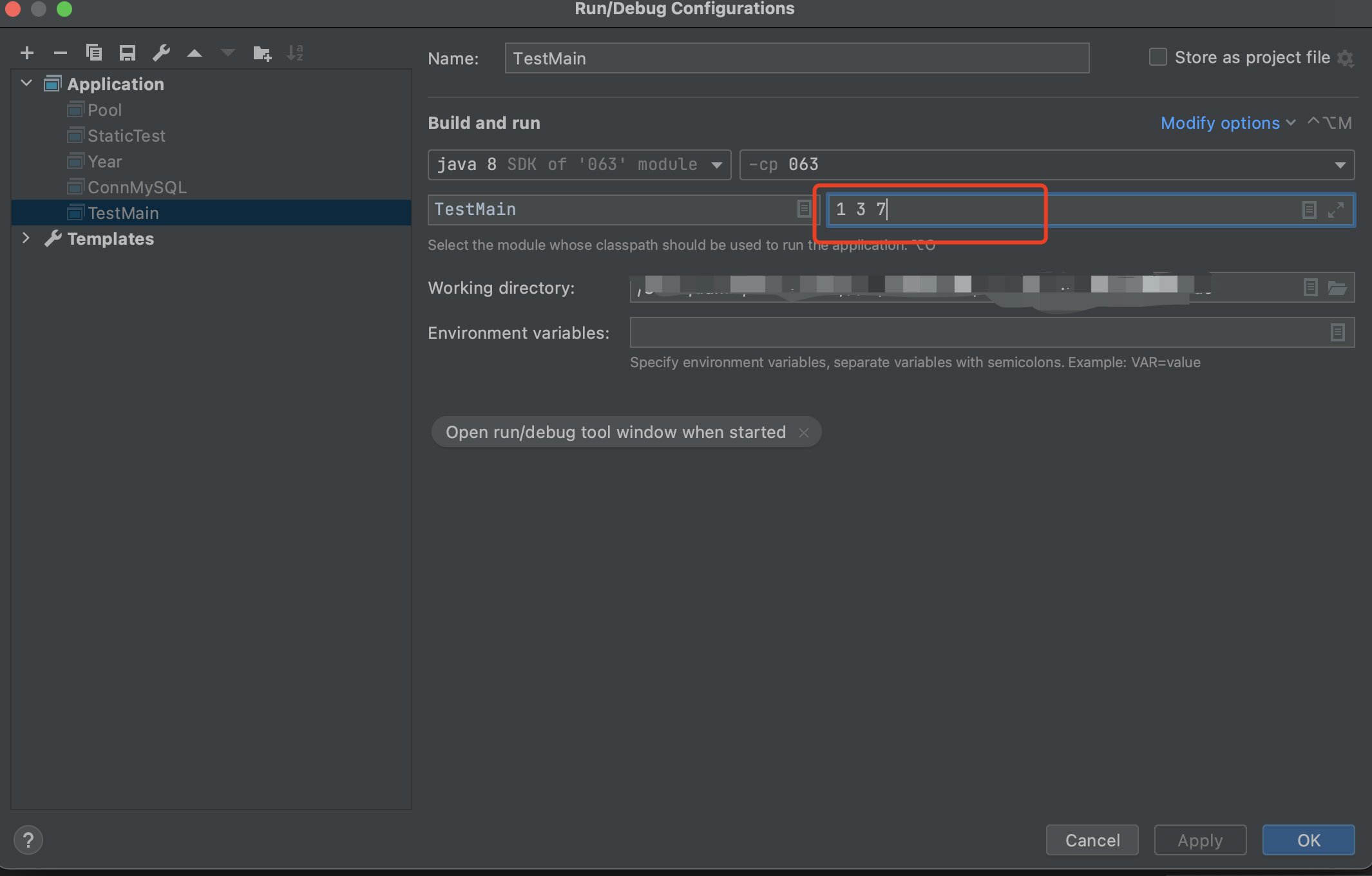构造方法
特点
- 没有返回类型,也不能定义void;
- 名称同本类相同;
- 主要作用:完成对象的初始化工作,能把对应对象的参数传给对象成员。
class B{ public B(){ //无参构造方法 } public B(int a,int b){ //有参构造方法 } }
public class Cellphone { /*public Cellphone() { System.out.println("智能手机的默认语言为英文"); } public Cellphone(String defaultLanguage) { System.out.println("将智能手机的默认语言设置为" + defaultLanguage); } public static void main(String[] args) { Cellphone cellphone1 = new Cellphone(); Cellphone cellphone2 = new Cellphone("中文"); }*/ public static void main(String[] args) { String lan = "中文"; Cellphone cp = new Cellphone(); Cellphone cp2 = new Cellphone(lan); } public Cellphone(String lan){ System.out.println("智能手机的语言可以设置为:"+lan); } public Cellphone(){ System.out.println("智能手机的默认语言为英文"); } }
this关键字
this关键字被隐式地用于引用对象的成员变量和成员方法。
public class Teacher { static String tnm = "A"; String nm= "AB"; public static void main(String[] args) { System.out.println("在main中直接访问class变量,变量定义时需有static字段,其名称:" + tnm); Teacher tc = new Teacher(); System.out.println("在main中,访问class成员变量,可通过对象.成员变量名称访问:"+tc.nm); String nm = "B"; tc.setname(nm); tc.setname2(nm); } public void setname(String nm) { System.out.println("\nclass变量:"+this.nm); System.out.println("不更新class中变量的值,传值名称:" +nm); System.out.println("class变量未更新:" +this.nm); } public void setname2(String name) { System.out.println("\nclass变量:"+this.nm); this.nm = name; System.out.println("更新class中变量的值,传值名称:" +nm); System.out.println("class中变量已更新:" +this.nm); } } /* 在main中直接访问class变量,变量定义时需有static字段,其名称:A 在main中,访问class成员变量,可通过对象.成员变量名称访问:AB class变量:AB 不更新class中变量的值,传值名称:B class变量未更新:AB class变量:AB 更新class中变量的值,传值名称:B class中变量已更新:B */
return this的目的、作用、使用场景
public class Teacher { String nm= "AB"; int age = 30; public static void main(String[] args) { Teacher tc = new Teacher(); String nm = "B"; int age = 20; /* 因为每个方法均返回了一个该类对应的对象,所以方法执行可简化。 tc.setname(nm).setname2(nm).setage(age); 同以下三行一个目的。 tc.setname(nm); tc.setname2(nm); tc.setage(age); */ tc.setname(nm).setname2(nm).setage(age); } public Teacher setname(String nm) { // return为本类,而非String、int等,所以 返回类型为本类名:Teacher System.out.println("\nclass变量:"+this.nm); System.out.println("不更新class中变量的值,传值名称:" +nm); System.out.println("class变量未更新:" +this.nm); /* this关键字引用的就是本类的一个对象, 类是无法返回的,需返回累的一个对象,如 方法返回的为String,return nm。同理,该场景则return this。 当返回的是一个对象时,该方法后可连着执行方法,从而简化代码。 */ return this; } public Teacher setname2(String name) { System.out.println("\nclass变量:"+this.nm); this.nm = name; System.out.println("更新class中变量的值,传值名称:" +nm); System.out.println("class中变量已更新:" +this.nm); return this; } public Teacher setage(int age) { System.out.println("\nclass变量:"+this.age); this.age = age; System.out.println("更新class中变量的值,传值名称:" +age); System.out.println("class中变量已更新:" +this.age); return this; } } /* class变量:AB 不更新class中变量的值,传值名称:B class变量未更新:AB class变量:AB 更新class中变量的值,传值名称:B class中变量已更新:B class变量:30 更新class中变量的值,传值名称:20 class中变量已更新:20 */
使用this在无参构造方法中调用有参构造方法
public class EggCake { int num=1; public static void main(String[] args) { EggCake ec = new EggCake(); System.out.println("此为有参构造方法"); EggCake ec2 = new EggCake(5); } public EggCake(int num){ // 有参构造方法 System.out.println("一共有:"+num+"个"); } public EggCake(){ // 无参构造方法,使用this调用有参构造方法,注:this前不应该有任何代码 this(2); System.out.println("此为无参构造方法\n"); } } /* 结果 一共有:2个 此为无参构造方法 此为有参构造方法 一共有:5个*/
static关键字
static可修饰变量、常量、方法,为静态变量、静态常量、静态方法。
静态变量
共享变量使用static修饰,则为静态变量,调用方法:类名.静态变量名称,不需创建对象即可访问。
作用范围:整个程序的生命周期,当程序结束后,静态变量销毁。(全局非静态变量作用是整个类,随着类的销毁而销毁)
public class Pool { // 创建水池类 /*int water = 0; //非静态变量 public static void main(String[] args) { Pool pool = new Pool(); int addc = 2; int subc = 2; System.out.println("初始:"+pool.water); //访问时,对象.成员名称 pool.add(addc); System.out.println("添加:"+addc+"次后:"+pool.water); pool.subtract(subc); System.out.println("减少:"+subc+"次后:"+pool.water); }*/ static int water = 0; //静态变量 public static void main(String[] args) { Pool pool = new Pool(); int addc = 2; int subc = 2; System.out.println("初始:"+Pool.water); //访问时,类.静态变量名称 本类下直接访问静态变量名称可行。 pool.add(addc); System.out.println("添加:"+addc+"次后:"+Pool.water); pool.subtract(subc); System.out.println("减少:"+subc+"次后:"+Pool.water); } public void add (int count){ //加水 count 次数 每次加3 for (int i = 1; i <= count ; i++) { water+= 3; } } public void subtract (int count){ //加水 count 次数 每次减水2 for (int i = 1; i <= count ; i++) { if (water >= 2) { water-= 2; } } } }
静态方法
调用:类名.静态方法名称(); 不需创建对象,即可访问。
public class Pool { // 创建水池类 static int water = 0; //静态变量 public static void main(String[] args) { int addc = 2; int subc = 2; System.out.println("初始:"+Pool.water); //访问时,类.静态变量名称 本类下直接访问静态变量名称可行。 Pool.add(addc); System.out.println("添加:"+addc+"次后:"+Pool.water); Pool.subtract(subc);//调用静态方法 类.静态方法 System.out.println("减少:"+subc+"次后:"+Pool.water); } public static void add (int count){ //加水 count 次数 每次加3 for (int i = 1; i <= count ; i++) { water+= 3; } } public static void subtract (int count){ //加水 count 次数 每次减水2 for (int i = 1; i <= count ; i++) { if (water >= 2) { water-= 2; } } } }
静态代码块
完成类的初始化操作,在声明类的时候即执行。
public class StaticTest{ static { //静态代码块, 对象声明时执行 System.out.println("静态代码块:对象声明时执行"); } { //非静态代码块, 对象赋值时执行 System.out.println("非静态代码块: 对象new时执行"); } StaticTest(){ //无参构造方法 System.out.println("无参构造方法"); } StaticTest(int n){ //有参构造方法 System.out.println("有参构造方法:"+n); } public static void main(String[] args) { System.out.println("对象声明啦"); StaticTest s1; System.out.println("\n对象new啦:默认调用无参构造方法"); StaticTest s2 = new StaticTest(); System.out.println("\n对象new啦:加入参数则调用有参构造方法"); StaticTest s3 = new StaticTest(2); } } /* 静态代码块:对象声明时执行 对象声明啦 对象new啦:默认调用无参构造方法 非静态代码块: 对象new时执行 无参构造方法 对象new啦:加入参数则调用有参构造方法 非静态代码块: 对象new时执行 有参构造方法:2*/
主方法
public class TestMain { public static void main(String[] args) { // 定义主方法 for (int i = 0; i < args.length; i++) { // 根据参数个数做循环操作 System.out.println(args[i]); // 循环打印参数内容 } } }
/* 1 3 7 Process finished with exit code 0*/




